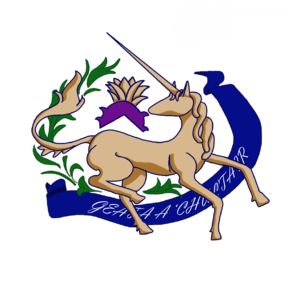The United Provinces of Dùnrath
| ||||||||||||||||||||||||||||||||||||||||||||||||||||||||||||||||
The United Provinces of Dùnrath, of which also known in full commons as The United Provinces of Dunrae, Vestlandet and the Borders, or known simply as Dùnrath or The United Provinces (Common: Dunrae (/dʌn.ˈre/),Sveasspråk: Ratteborg) is a monarchical political entity made up of individuals of different races. It was established after the Proclamation of the United Provinces in year 70 of the second age by the last Jarl of Dùnrath, Dùghlas Sutharlainn, of which he decided to divide up his power to other governmental departments.
Contents
History
Pre-War of Wigs Era (42 – 60 S.A.)
Before year 42 of the Second Age, even though the sovereignty was secured by the Norlandic Government from the Raenrland Decree on year 20 of the second age, its population is highly concentrated to the western part of the region, closer to the Norland Proper. On the other hand, the South-eastern part of Raenrland was sparsely inhabited by nomads and tribal people of the region, of which will be called the “Aboriginals” in the future by the Rathonian Authorities. On year 42 of the Second Age, the Sutherland Corporation, at the time a multinational business venture, and the Clan Chief of the United Clans of Barr and Suther, Daibhidh MacFhilib Sutharlainn stroked a deal with the Norland King at the time, Vane Freysson Ruric, to set up a merchant political entity in the South-eastern part of Raenrland, and they both signed the Helmsdale Agreement to warrant the creation of a new political entity, of which Norland sold the lands of Rath and Vestlandet to the United Clans. Soon, the news of the new established merchant colony spread across the continent and attracted a substantial amount of Sutican and Urguani people to move into the colony and cultivate the virgin land. On year 45, Daibhidh Sutharlainn decided to enact Article 6 of the Helmsdale Agreement of which he is reorganising the merchant colony to a Barony of the Kingdom of Norland, named the Barony of Dùnrath. The barony was given a substantial amount of autonomy under the Kingdom of Norland by the Helmsdale Agreement and the Rathonian Diplomatic Agreement, of which ensured the absolute independent in all Legislative, Administrative and Judicial matters, and partial-independent in Diplomatic matter. The Barony then exist under the Kingdom of Norland as, “A Political Entity of the Kingdom of Norland with a high degree of autonomy”. On year 53 of the Second Age, the Baron of Dùnrath at the time, once again stroked another deal with the King of Norland to expand its borders to tackle the over-population issue in the city of Dùnrath. Hence the South Dunbar Agreement was officially signed, which Norland sold the lands of Osmode, Östlandet, South Dunbar and Gräns-Kristianstad to the United Clans. Moreover, the United Clans of Barr and Suther was also given a Jaric title by the Norlandic Government. This marked the border and the political position of the Pre-United Province of Dùnrath. On year 56 of the Second Age, the Jarl of Dùnrath at the time agreed to sell land to the clan leader of the Anarórë Clan, Boots Anarórë and set up a fortified villiage by the Gräns-Kristianstad neighbourhood, and the villiage was subsequently named in Waldenian as Grenzstadt (Agnesa:Baile nan Crìochan, Sveasspråk: Gränsstad), not long after that, the Norlandic Crown gave the title of Laird of Grenzstadt to the Anarórë Clan. The Lairdship takes up around 40% of land of the current day Province of Gräns- Bromölla.
War of Wigs Era (60 – 70 S.A.)
The Kingdom of Norland joined the War of Wigs from year 54. However, it is not until year 60 that the Rathonian Government start preparing for possible military engagement with the Holy Orenian Empire at the time. On year 61, the Orenian Army, known as the Imperial State Army (ISA) started large scale of assaults throughout the Southern Borders and threatened the safety of rural areas of the Jarldom. On year 63, the ISA launched a full-scale raid throughout the lands of Norland, from Krew, Varhelm, and Dùnrath. Hence a skirmish happened between the ISA and the Rathonian Citizens, since at the time there were no Ashguard Garrisons in the region. The Rathonian Citizen Units, being way more underprepared and inexperienced in comparison with the ISA lost the battle against them and the ISA subsequently raided the Little Matilda Ranch in Osmonde, this is known in history as the Skirmish of Osmonde-Östlandet. That particular action sparked the Anti-Oren sentiment in Dùnrath and strengthen the determination of winning the war. The Rathonians have participated in several operations and skirmishes including the Sacking of Stone Tower, the Battle of Haverlock Fields, and the Siege of Haverlock. On year 69, which is the year before the Battle of East Fleet, following the statement by the Marshal of Norland at the time, Ragnvald Eiriksson Ruric, the People’s Council of Dùnrath also issued a statement with the heading: “When the Sun Shines Brightly on the Blue Sky.” (Agnesa: Nuair a dheàrrsas a’ ghrian gu soilleir air an speur gorm. Sveasspråk: När solen lyser klart på himmlen blå) which the Rathonian Government condemned the action and warcrimes done by the Orenian Authorities.
United Provinces Era (70 S.A. - Present)
On year 70, two years before the end of the War of Wigs. The Last Jarl of Dùnrath, Dùghlas Sutharlainn decided to give up part of his administrative power and establish local governors governing their respective regions. Hence the United Provinces of Dùnrath is established, with the last Jarl of Dùnrath as the first Grand Governor of the United Provinces. Two years later, the War of Wigs was ended, and peace was achieved after the war. Subsequently the Rathonian Government started a lot of building projects including the Port of Dun’avi, the Finlaggan Place, and the finalisation of the Östlandet keep. On year 72, the Grand Govenor of Dùnrath and the King of Norland of the time, King Ragnvald Eiriksson Ruric signed the Gräns- Bromölla Agreement, expanding the United Provinces futher and enabled Dùnrath to grow further.

